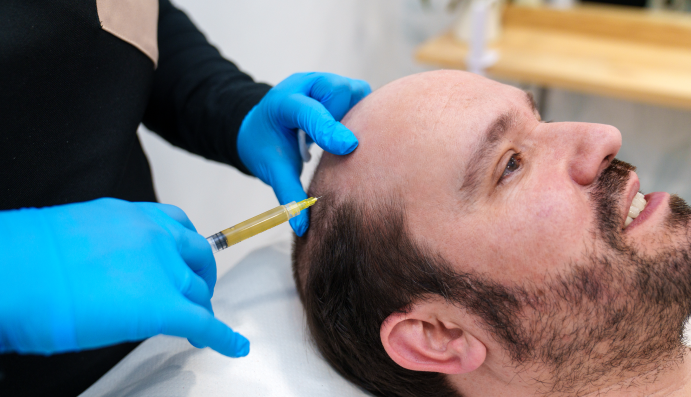Platelet-Rich Plasma (PRP) treatment has gained significant popularity as a non-surgical solution for hair loss and skin rejuvenation. This innovative therapy harnesses the body’s natural healing powers to stimulate tissue regeneration and enhance overall skin and hair health. In this blog, we’ll explore what PRP treatment entails, its benefits, potential side effects, and cost considerations
What is PRP Treatment?
PRP treatment involves using a patient’s blood to create a concentrated mixture of platelets and growth factors. These components play a crucial role in healing and tissue regeneration, making PRP an effective therapy for various medical and cosmetic applications.
Applications of PRP Treatment:
- Hair Loss: PRP is used to stimulate hair follicles and promote hair growth in individuals suffering from thinning hair or alopecia.
- Skin Rejuvenation: PRP is also popular in aesthetic medicine for enhancing skin texture, reducing wrinkles, and promoting a youthful appearance.
How PRP Treatment Works
The PRP treatment process is straightforward yet highly effective. Here’s a step-by-step breakdown:
- Blood Collection: A small amount of blood is drawn from the patient.
- Centrifugation: The blood is placed in a centrifuge to separate the platelets from other blood components.
- Platelet Concentration: The platelets are concentrated into a rich plasma, known as PRP.
- Injection: The PRP is injected into the targeted area, whether it’s the scalp for hair growth or the skin for rejuvenation.
The growth factors in PRP stimulate the body’s natural healing process, encouraging the regeneration of tissues and the production of collagen and elastin.
Benefits of PRP Treatment

PRP treatment offers a range of benefits, making it a versatile solution for various cosmetic concerns
Popular Activities and Experiences
- Hair Loss Treatment
PRP therapy is particularly effective for treating hair loss. By stimulating dormant hair follicles, PRP encourages new hair growth and improves hair density. It’s a popular choice for individuals who prefer non-surgical methods for hair restoration.
- Skin Rejuvenation and Anti-Aging
PRP is widely used for skin rejuvenation. It improves skin texture, reduces fine lines and wrinkles, and enhances overall skin tone. The treatment promotes collagen production, which is essential for maintaining youthful skin.
- Wound Healing and Tissue Regeneration
PRP is not only used for cosmetic purposes but also in medical treatments. It accelerates wound healing and aids in tissue regeneration, making it valuable in both medical and aesthetic applications.
PRP Treatment for Hair Loss
Hair loss is a common concern for many, and PRP therapy offers a promising solution. Here’s how it works:
- Mechanism of Action: PRP stimulates hair follicles by delivering growth factors that promote hair growth and prevent hair thinning.
- Success Rates: Many patients report noticeable improvements in hair thickness and growth after undergoing PRP therapy. Results may vary, but consistent treatments can lead to significant hair restoration.
- Combining PRP with Other Treatments: PRP can be combined with other hair loss treatments, such as microneedling or topical therapies, to enhance results.
PRP Treatment for Skin Rejuvenation
PRP’s benefits extend beyond hair restoration, offering impressive results in skin rejuvenation:
- Improvement in Skin Texture and Tone: PRP treatments boost collagen production, resulting in smoother, firmer skin with improved elasticity.
- Reduction of Fine Lines and Wrinkles: The growth factors in PRP help to reduce the appearance of fine lines and wrinkles, giving the skin a more youthful appearance.
- Combination with Other Treatments: PRP can be paired with treatments like microneedling or dermal fillers for even more dramatic results.
Risks and Side Effects
Risks and Side Effects
While PRP treatment is generally safe, it’s important to be aware of potential risks and side effects:
- Complications: Although rare, some patients may experience infection, bruising, or pain at the injection site.
- Temporary Side Effects: Common side effects include redness, swelling, and tenderness in the treated area. These effects typically subside within a few days.
Consulting with a qualified healthcare provider is essential to minimize risks and ensure a safe treatment experience
PRP Treatment Cost
The cost of PRP treatment can vary based on several factors:
- Area Treated: The cost may differ depending on whether you’re treating hair loss, skin rejuvenation, or another condition.
- Number of Sessions: Multiple sessions may be required to achieve the desired results, which can impact the overall cost.
- Average Cost Range: On average, PRP treatments can range from INR 6,500 to 12,000 per session, depending on the provider and location.
- Insurance Coverage: PRP is often considered a cosmetic procedure, and therefore, it may not be covered by insurance. It’s best to check with your insurance provider for details.
A typical PRP session takes about 45 minutes to an hour, including blood collection, preparation, and injection.
Results can vary, but many patients notice improvements within a few weeks to a few months after treatment. Multiple sessions may be needed for optimal results
The procedure involves injections, which can cause some discomfort. However, most patients find the treatment tolerable, and numbing agents can be used to minimize pain
For hair loss treatment, most patients require 3-4 sessions spaced about a month apart, followed by maintenance treatments every 6-12 months
Yes, PRP can be combined with other treatments like microneedling, laser therapy, or topical treatments for enhanced results